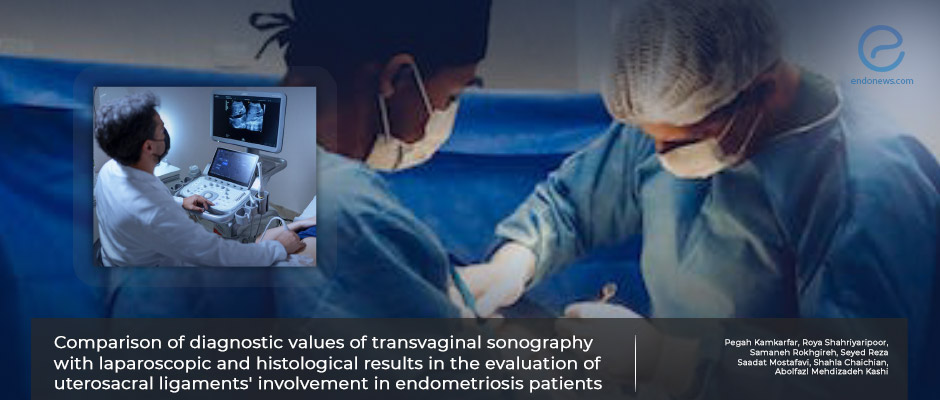Diagnostic criteria for uterosacral ligament involvement in endometriosis.
Jan 18, 2023
Transvaginal ultrasound has an acceptable sensitivity in the diagnosis of uterosacral involvement in endometriosis.
Key Points
Importance:
- Transvaginal and transrectal ultrasonography are effective enough in accurately diagnosing endometriosis with uterosacral involvement, without ignoring that the gold standard is laparoscopy.
Highlights:
- According to the current study, sensitivity, specificity, and positive and negative values support the predictive value of ultrasonographic examination in the diagnosis of uterosacral endometriosis.
What's done here:
- An Iranian research team planned a comparison of the diagnostic values of transvaginal ultrasonography with a laparoscopic approach and histologic results to evaluate the uterosacral involvement of endometriosis.
Key Results:
- The study included 80 women: the thickness of the uterosacral ligament by ultrasonographic examination was detected in 81,2%.
- Histopathologic confirmation of endometriosis on uterosacral ligaments after laparoscopy showed almost parallelity with ultrasonographic findings.
- The study's sensitivity, specificity, and positive and negative predictive values of diagnosing uterosacral endometriosis were 82%, 100%,100%, and 6,66%, respectively.
Lay Summary
Transvaginal ultrasonography is often used to diagnose endometriosis in suspected women due to its high resolution, low cost, and relatively low discomfort. Histologic confirmation of laparoscopically removed specimens is still the gold standard for appropriate diagnosis.
The team led by Dr. Mehdizadeh Kashi, from the Department of Obstetrics and Gynecology of Iran University, Tehran, Iran, intended to evaluate the diagnostic accuracy of transvaginal ultrasonography in uterosacral ligament involvement through a cross-sectional study carried out during 2019-2020. The results have recently been published in the Caspian Journal of Internal Medicine.
A transvaginal ultrasonographic evaluation of 80 patients by measuring the increase in the thickness of uterosacral ligaments and the presence of overlying hypoechoic nodules was performed, and, during the laparoscopy, uterosacral ligaments were carefully scrutinized. Histopathologic examination of the laparoscopically resected specimens was statistically compared for specificity, sensitivity, and positive and negative predictive values using statistical software.
The sensitivity, specificity, and positive and negative predictive values, compared with pathology-confirmed laparoscopy were 93%, 65%, 87%, and 78.9%, respectively. Furthermore, the thickness of uterosacral ligaments evaluated along with the overlying hypoechoic areas these values increased to 82%, 100%, 100%, and 6.66%, respectively. Interestingly, it was 100% for all four parameters in the diagnosis of endometrioma.
The authors concluded that transvaginal ultrasonography can be safely used in the diagnosis of endometriosis by examining the increase in the thickness of the uterosacral ligament and the presence of overlying hypoechoic nodules, and this method demonstrates acceptable sensitivity and specificity in ovarian endometrioma.
Research Source: https://pubmed.ncbi.nlm.nih.gov/36420326/
traansvaginal ultrasonography laparoscopy uterosacral ligament histopathologic diagnosis endometrioma DIE endometriosis.

